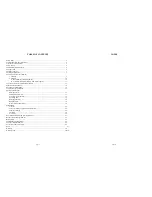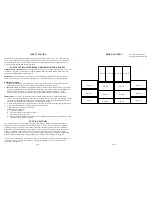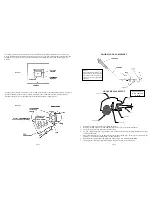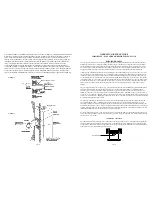
Page 9
A chimney must be the required height above the roof or other obstruction for safety and proper draft operation.
The chimney must be a minimum of 3 (914mm) higher than the highest point where it passes through the roof,
and at least 2 (610mm) higher than the highest part of the roof or structure that is within 10 (3048mm) of the
chimney, measured horizontally (Figure 7).
Remember that insulation must not contact the chimney. There must be air space around the chimney.
Insulation must be 2 (50mm) or more from the chimney (Figure 6).
FIGURE 6
FIGURE 7
Page 20
Page 20
MAINTENANCE
CREOSOTE
1.
Formation and need for removal
: When wood is burned slowly, it produces tar and other organic vapors which
combine with expelled moisture to form creosote. The creosote vapors condense in the relatively cool chimney flue of
a newly-started or a slow-burning fire. As a result, creosote residue accumulates on the flue lining. When ignited, this
creosote creates an extremely hot fire which may damage the chimney or even destroy the house. The chimney
connector and chimney should be inspected at least twice monthly during the heating season to determine if a creosote
buildup has occurred. If creosote has accumulated, it should be removed to reduce the risk of a chimney fire.
2.
Inspection
: Inspect the system at the stove connection and at the chimney top. Cooler surfaces tend to build creosote
deposits quicker, so it is important to check the chimney from the top as well as from the bottom.
3.
Removal
: The creosote should be removed with a brush specifically designed for the type of chimney in use. A
chimney sweep can perform this service. It is also recommended that before each heating season the entire system be
professionally inspected, and cleaned and repaired if necessary.
CARE AND CLEANING OF GLASS
NOTE: Remove all labels from glass before lighting the first fire in your stove.
Quadra-Fire stoves are equipped with ceramic super heat-resistant glass, which can only be broken by impact or misuse.
Do not slam stove door or impact the glass. When closing door, make sure that logs do not protrude against the glass.
Clean glass with a nonabrasive glass cleaner, such as Windex. Abrasive cleaners may scratch and cause glass to crack.
Inspect glass regularly. If you find a crack or break, immediately put the fire out and return the door to your dealer for
replacement of glass before further use.
NOTE
: Replace with ceramic glass only.
CARE AND CLEANING OF PLATED SURFACES
Clean 24 karat gold-plated surfaces with vinegar or a glass cleaner before lighting your first fire.
WARNING: When the appliance is equipped with a 24 karat gold-plated door, you must clean all the
fingerprints and oils from the gold surface before firing the appliance for the first time. Use a glass
cleaner or vinegar and towel to remove the oils. If not cleaned properly before lighting your first fire, the
oils can cause permanent markings on the gold plating. After the gold plating is cured, the oils will not
affect the finish and little maintenance is required: just wipe clean as needed.
CAUTION: D
O
NOT
USE
POLISHES
WITH
ABRASIVE
AGENTS
. T
HEY
WILL
SCRATCH
THE
PLATING
.
CHIMNEY CLEANING
Disconnect flue pipe from stove before cleaning chimney. Otherwise residue can pile up on top of the baffle, and the
stove will not work properly.
ASH REMOVAL
Remove cold ashes (NEVER HOT) from the stove by shoveling them into a metal container with a tight-fitting lid.
Spraying cold ashes with water before shoveling them out of the stove will help eliminate ash flying around the firebox
and into the room. Always treat ashes as if they contain hot coals, and store the container on a noncombustible floor away
from combustible material pending final disposal.
FIREBRICK
The firebox of your Quadra-Fire stove is lined with high quality firebrick, which has exceptional insulating properties.
There is no need for use a grate; simply build a fire on the firebox floor of your stove.
OVERFIRING
Do not overfire. Using flammable liquids or too much wood, burning trash in the stove, or allowing too much air into the
stove, may result in overfiring. If the chimney connector or stove glows red or even worse, white, the stove is overfired.
This condition may ignite creosote in the chimney, which can be dangerous, possibly causing a house fire. If you overfire,
immediately close the air control and door, if open, to reduce the air supply to the fire.














